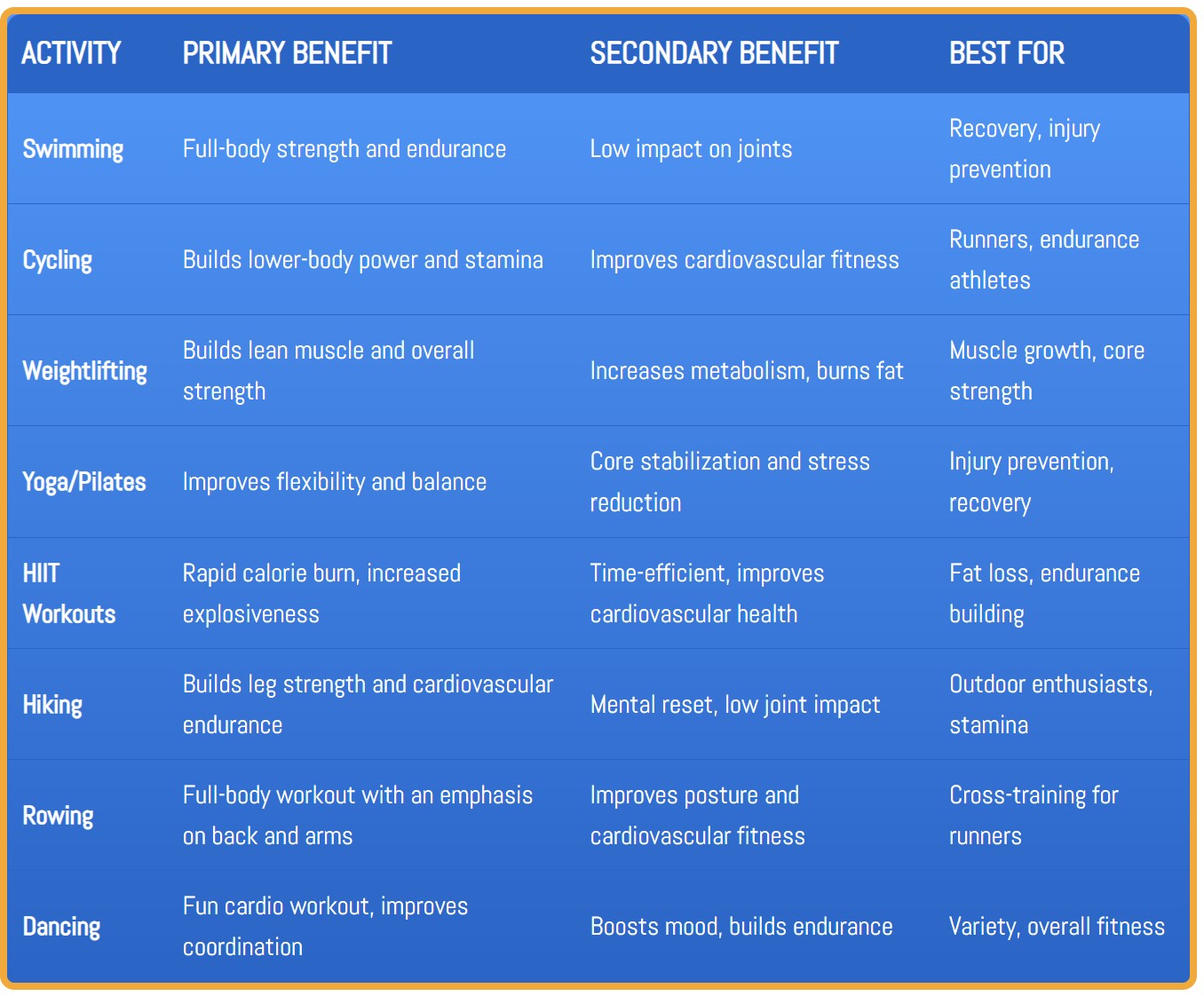Alright, let’s cut to the chase. Cross-training is the single most underrated fitness hack you’re not doing right now. Why? Because it’s the psychological cheat code for people who want to get fit but always find themselves quitting halfway through. If you’ve ever felt bored, stuck, or overwhelmed by your training program, this is your way out.
It’s not just about improving fitness; it’s about keeping your mind in the game while your body crushes new limits.
What is Cross-Training?
Let me break it down in a way that actually makes sense:
Cross-training is when you combine different activities and exercises to improve your overall fitness, instead of hammering the same routine into the ground. Think of it like crossfit, but without needing a cult-like group screaming at you while flipping tires.
It’s for everyone—from marathon runners to people who just want to look good naked.
Cross-Training Activities and Benefits Chart

The Benefits: Why You Should Care
Cross-training isn’t just some fitness buzzword. It works, and here’s why:
| Benefit | Explanation |
|---|---|
| Break Plateaus | Mixing it up lets you develop new skills and build muscle in ways your body isn’t used to. |
| Injury Prevention | Particularly useful for avoiding overuse injuries, which wreck runners and gym-goers alike. |
| Increased Endurance | Activities like swimming or cycling improve stamina while reducing joint strain. |
| Faster Recovery | Low-impact exercises help you recover after intense sessions, keeping you in the game. |
| Mental Variety | You don’t quit because it stays fresh and interesting. Say goodbye to boring workouts. |
You’ll also burn more calories (cross-training kicks up your metabolism), build lean muscle mass, and improve explosiveness for sports or life.
How to Design a Cross-Training Program
You don’t need a complex system. You just need a plan that fits your goals. Here’s a quick guide to building a program that’ll make you unstoppable:
1. Assess Your Fitness Goals
- Want to run faster? Add strength training to boost power and endurance.
- Want to avoid injuries? Swap some runs for low-impact options like cycling or swimming.
- Want to shred fat? Incorporate high-intensity interval training (HIIT) to burn more calories in less time.
2. Choose Your Core Activities
Here are some killer options to rotate through:
- Strength: Weightlifting, bodyweight exercises, or resistance bands.
- Cardio: Swimming, running, or cycling.
- Flexibility and Balance: Yoga, Pilates, or stretching routines.
- Dynamic Mixers: Hiking, dancing, or brisk walking.
3. Determine Your Weekly Schedule
- 2-3 sessions per week: Enough to start seeing noticeable results.
- Focus on variety: Don’t repeat the same exercise two days in a row.
- Stick with it for at least 8 weeks to crush your goals.
4. Track and Adjust
This isn’t set in stone. If you feel burnt out or not improving, change it up. Add something new—kickboxing, rowing, or even CrossFit-style circuits.
Psychology Hack: Why Cross-Training Works
Here’s where this gets interesting. The biggest reason people quit their workouts isn’t the physical side—it’s the mental game. Cross-training helps by keeping your brain engaged, which makes you less likely to give up.
Here’s how:
- Variety Kills Boredom: Doing different workouts feels fresh. You’ll look forward to it instead of dreading it.
- Improved Motivation: Seeing progress in new areas (like learning to swim or improving balance) gives you a confidence boost.
- Prevents Burnout: Mixing low- and high-intensity activities prevents you from overdoing it.
Bottom line: Cross-training turns fitness into a game you can actually win.
Who Should Do Cross-Training?
The short answer? Everyone.
The long answer? Here’s who it works for:
- Runners
If you want to run longer distances or improve your speed without wrecking your knees, add in strength training or cycling. - Athletes
Cross-training builds power, explosiveness, and core strength that translates across sports like basketball, football, and martial arts. - People with Fitness Plateaus
If you’ve stopped seeing results, cross-training introduces new challenges to break through. - Beginners
Not sure where to start? A customized cross-training plan is a highly effective way to build stamina, strength, and endurance—all at once.
Common Mistakes to Avoid
Let’s talk about what not to do—because screwing this up is easier than you think.
- Going Too Hard, Too Fast
If you’re new, don’t jump into intense workouts every day. You’ll burn out or get injured. Start slow and build up. - Ignoring Recovery
Cross-training doesn’t mean skipping rest days. Recovery is part of the process. Sleep, eat well, and stretch it out. - Lack of Focus
Just doing random exercises won’t help. You need a specific goal and a program designed to get you there.
The Business Angle: Cross-Training for Life
This isn’t just about fitness—it’s about applying cross-training to everything you do. Want to crush your business goals? Think of cross-training as a metaphor. Don’t rely on one single skill. Develop variety:
- Build your expertise across different areas.
- Empower your team by letting them share knowledge and remove bottlenecks.
- Prevent burnout by outsourcing tasks appropriately.
Cross-training isn’t just for athletes—it’s a mindset for making progress everywhere.
Final Thoughts: Cross-Training is Your Secret Weapon
Cross-training isn’t just about fitness goals—it’s about building a sustainable plan that keeps you engaged, motivated, and improving.
- Want to run a marathon? Cross-train.
- Want to build lean muscle mass? Cross-train.
- Want to stop quitting every time you start a program? You guessed it—cross-train.
No fluff, no excuses. Start now, stick to it for 8 weeks, and you’ll see noticeable improvements in your strength, endurance, and overall fitness. The results will speak for themselves.
